The Italy Sustainable Tourism Market is estimated to be valued at USD 52.4 million in 2025 and is projected to reach USD 202.9 million by 2035, registering a compound annual growth rate (CAGR) of 14.5% over the forecast period.
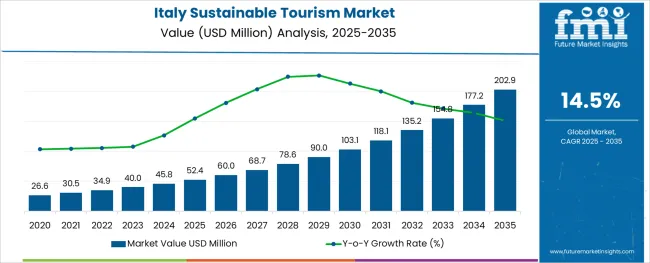
The Italy sustainable tourism market is undergoing substantial evolution as travelers, policymakers, and industry stakeholders prioritize environmental and cultural preservation. A combination of national-level commitments to green tourism, expanding slow travel trends, and increased visibility of eco-conscious travel options is contributing to heightened interest in sustainability-aligned experiences.
Italian regions with protected landscapes and heritage sites are witnessing growing investment in low-impact infrastructure and conservation-centered visitor programs. Consumer preference is shifting toward meaningful, localized experiences that align with sustainability values, with an emphasis on supporting regional economies and reducing the carbon footprint of travel.
Digital platforms are amplifying the reach of sustainable operators and experiences while government incentives are encouraging businesses to adopt eco-certifications and green practices. As Italy balances tourism promotion with ecological stewardship, the sustainable tourism market is expected to gain further traction through innovation, policy integration, and strategic partnerships.
The market is segmented by Tourism Type, Booking Channel, Tourist Type, Tour Type, Consumer Orientation, and Age Group and region. By Tourism Type, the market is divided into Eco-Tourism, Green Tourism, Soft Tourism, and Community Tourism. In terms of Booking Channel, the market is classified into Online Booking, In-Person Booking, and Phone Booking. Based on Tourist Type, the market is segmented into Domestic and International. By Tour Type, the market is divided into Independent Traveller, Tour Group, and Package Traveller. By Consumer Orientation, the market is segmented into Women and Men. By Age Group, the market is segmented into 26-35 Years, 36-45 Years, 46-55 Years, 66-75 Years, and 15-25 Years. Regionally, the market is classified into North America, Latin America, Western Europe, Eastern Europe, Balkan & Baltic Countries, Russia & Belarus, Central Asia, East Asia, South Asia & Pacific, and the Middle East & Africa.
The market is segmented by Tourism Type, Booking Channel, Tourist Type, Tour Type, Consumer Orientation, and Age Group and region. By Tourism Type, the market is divided into Eco-Tourism, Green Tourism, Soft Tourism, and Community Tourism. In terms of Booking Channel, the market is classified into Online Booking, In-Person Booking, and Phone Booking. Based on Tourist Type, the market is segmented into Domestic and International. By Tour Type, the market is divided into Independent Traveller, Tour Group, and Package Traveller. By Consumer Orientation, the market is segmented into Women and Men. By Age Group, the market is segmented into 26-35 Years, 36-45 Years, 46-55 Years, 66-75 Years, and 15-25 Years. Regionally, the market is classified into North America, Latin America, Western Europe, Eastern Europe, Balkan & Baltic Countries, Russia & Belarus, Central Asia, East Asia, South Asia & Pacific, and the Middle East & Africa.

Within the tourism type category, eco-tourism is projected to account for 29.4% of the Italy sustainable tourism market revenue in 2025, establishing it as the leading subsegment. This growth is being driven by an increasing traveler inclination toward nature-based, conservation-oriented travel experiences that foster awareness and engagement with the environment.
Eco-tourism destinations in Italy, often situated in national parks and rural regions, are being supported by local communities and regional governments to ensure low-impact development and preservation of biodiversity. The rise of experiential travel, combined with consumer sensitivity to overtourism and climate change, has contributed to the subsegment’s appeal.
Moreover, eco-tourism providers are emphasizing small group travel, educational programming, and authentic cultural interactions, which have resonated strongly with conscious travelers and elevated eco-tourism as a priority within Italy’s sustainable tourism portfolio.
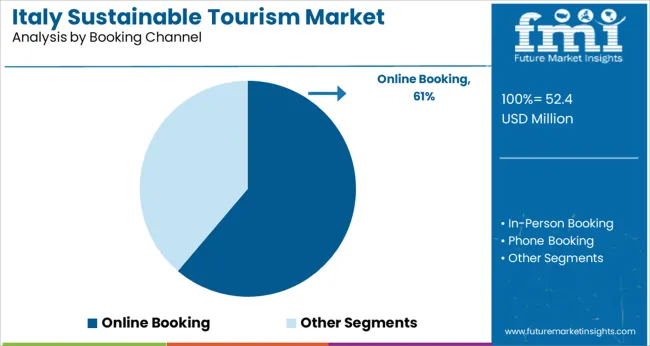
The online booking segment is expected to capture 61.2% of revenue under the booking channel category in 2025, making it the dominant method of trip planning and reservation. This leadership is supported by a generational shift in booking behavior, with digital-native travelers seeking seamless, mobile-first platforms to research, compare, and reserve sustainable travel options.
Online platforms have enabled transparent visibility into eco-certifications, carbon offset offerings, and local impact metrics, which has strengthened consumer confidence in choosing responsible travel services. Aggregators and direct booking portals alike are prioritizing user experience by highlighting sustainability filters and partnering with responsible operators.
Real-time availability, personalized recommendations, and digital itineraries have become critical in shaping traveler decisions, reinforcing the preference for online booking as the most efficient and informative channel in the sustainable tourism ecosystem.
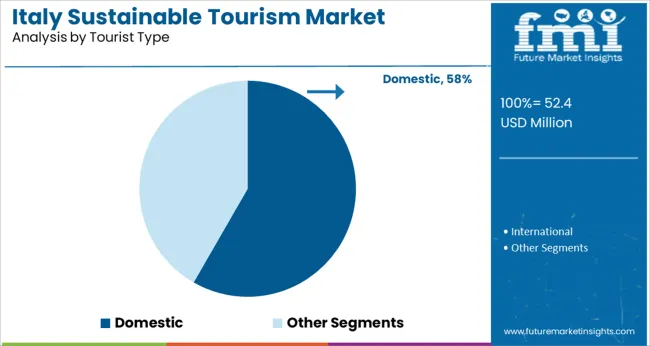
Domestic tourists are anticipated to contribute 58.3% of revenue in 2025 under the tourist type category, placing them at the forefront of sustainable travel within Italy. This dominance is underpinned by a growing national awareness of ecological preservation, as well as the increasing popularity of local, short-distance travel experiences that reduce environmental impact.
Italian residents are engaging more with regional heritage, slow mobility networks, and agritourism experiences that emphasize cultural continuity and resource conservation. Economic factors including inflation and global uncertainty have also steered travel behavior toward domestic exploration, where consumers find value in rediscovering lesser-known destinations.
Local tourism boards and communities are supporting this trend through eco-label programs, investment in green accommodations, and development of educational trails, all of which have deepened the role of domestic tourism as the backbone of Italy’s sustainable tourism framework.
According to Future Market Insights, sustainable tourism in Italy is anticipated to increase dramatically at a stupendous CAGR of 14.5% during the forthcoming decade.
Italy is well-known around the world for its tourist destinations and food. It’s great cities of art, like Rome, Venice and Florence are world famous and have been attracting visitors for centuries. The country is also quite famous for its warm hospitality and is accustomed to welcoming pilgrims to the Eternal City from all across Europe and other regions.
The Italian government and industry players are increasingly aware that sustainable tourism will become the only possible tourism model in the medium-to-long term. As a result, they are using various strategies to promote sustainable tourism in the country.
Breath-taking Landscapes and Cultural Treasures Making Italy an Ideal Sustainable Tourism Destination
One of the key factors impacting the sustainable tourism industry in Italy is the presence of beautiful and calm landscapes as well as cultural and historic treasures.
Italy is considered as one of the most beautiful countries in the world. It flaunts the most inspiring treasures and magnificent scenery, which cannot be found in other places of the world.
Thanks to its extraordinary diversity, rich culture, and presence of beautiful cities like Rome and Venice, Italy has become a well-liked tourism destination. Therefore, it is essential to safeguard the sustainability of the tourist industry.
The majority of countries now recognize the significance of sustainable tourism as a critical global trend for the growth of the tourist sector. So, countries like Italy are taking various steps to boost sustainable tourism.
Social Media Playing a Key Role in Promoting the Sustainable Tourism Industry in Italy?
Social media's introduction has caused a paradigm shift in communication methods globally by enabling users to connect, observe, and share information. The way tourist industry operates has been altered as a result of social media's development as new technology. This has had a big impact on the sustainable tourism industry.
Tourism providers may keep in touch with other stakeholders by using social media platforms like Facebook, Instagram, Twitter, Google, and Pinterest. A paradigm change in worldwide purchasing habits has been brought about by the internet's development throughout time.
The local populace benefits from and is empowered by tourism, a significant revenue-generating sector. As a result, a convenient strategic media platform is needed for the promotion.
According to the study, actively promoting sustainable tourism locations on social media platforms will increase the exposure and accessibility of the destination to tourists. Therefore, information shared by both locals and visitors via social media is significantly contributing towards Italy's sustainable tourism revival.
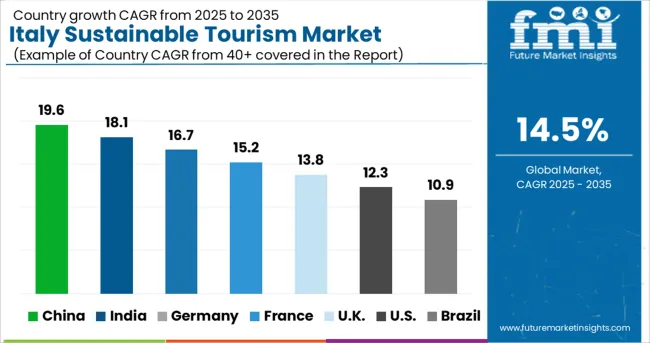
Growing Awareness Among Tourist to Foster Growth of Italy’s Sustainable Tourism Industry
Over the years, there has been a significant rise in awareness levels among people about sustainable tourism and its benefits. This has ignited the growth of sustainable tourism industry in the country and the trend is likely to continue during the forecast period.
Due to its many cultural and regional patterns, Italy is one of the most notable nations in Europe working to achieve sustainable tourism. The importance of sustainable tourism is rising in the area. Also, Italy's economy has grown as a result of responsible tourism since it brings in money for the government.
Focus Towards Encouraging Sustainable Travel by Assisting Tourism Businesses Remains a Key Motive of Government
According to data from the Central Bank of Italy, the tourist sector contributed more than 5% of Italy's GDP and 6% of all national employment in 2020. Furthermore, 26.6 million international visitors spent 44.3 billion euros in Italy in 2020. (USD 52.5 billion).
Similarly, according to the National Tourism Agency (ENIT), Italy officially launched a project backed by the European Union (EU) to help tourism businesses become eco-friendlier and make better use of the post-pandemic opportunities. The project is aimed at encouraging entrepreneurs and innovators in the industry as well as trailblazers from other economic sectors to network with SMEs.
The project's participants would gain knowledge and skills for managing sustainable tourism, or for starting the ecological transformation of their companies.
Through its initiative for SMEs, the European Union co-finances the EU Eco-Tandem project (COSME). From Italy, Germany, Austria, Slovakia, and Greece, it brings together scholars and authorities in the fields of innovation and sustainable development. managerial abilities.
Millennials are Particularly Fond of Sustainable Travel.
In 2024, Italy’s sustainable tourism market was led by the 26 to 35-year-old age group segment. Furthermore, this segment is expected to grow at a prolific pace during the forecast period. This can be attributed to the rising awareness about sustainability among people of the 26-35 age group.
Growth of this segment is also due to surge in millennial population and their growing concern for the environment. The importance of millennial travelers, who make up the largest generational group of travelers, in the development of sustainable tourism is growing rapidly.
Rising Trend of Solo-Trips to Boost Growth in Italy Sustainable Tourism Market
One of the main causes of the rise in independent travelers is the growing number of lone wolves among the millennial and generation Z populations. Independent travelers have been driven to visit isolated locations in their quest to discover uncharted territory.
Along with this, trends that demonstrate a rising need for genuine vacation experiences include individuality, the search for a range of experiences, self-improvement, experimentation, and heightened social and environmental awareness.
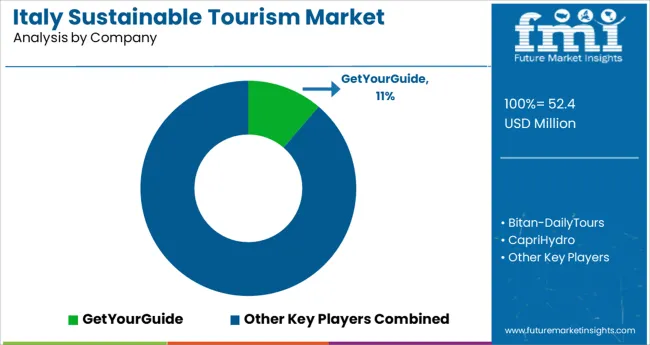
As the Italian government and key players in the business are becoming more and more conscious about sustainable tourism, they are striving hard to develop and expand the industry in the country. For instance, in 2024, Italy officially launched an EU-backed project to promote eco-friendly tourism.
Similarly, companies like Ecobnb, an innovative start-up offering a network of eco-sustainable accommodations, are guiding growth in the Italy sustainable tourism industry.
Ecobnb is working hard to offer an alternative tourism experience to travelers, while bringing together a community of responsible tourists that contribute to the promotion of sustainable tourism and the preservation of the environment. The company received co-financing for the implementation of the booking system in 2020 under FESR 2014 to 2024 program.
Another company that provides responsible travels to Italy, with a special focus on the country’s sustainability is Asolando.
| Attribute | Details |
|---|---|
| Estimated Market Size (2025) | USD 52.4 million |
| Projected Growth Rate (2025 to 2035) | 14.5% CAGR |
| Forecast Period | 2025 to 2035 |
| Historical Data Available for | 2020 to 2024 |
| Market Analysis | million for Value |
| Key Region Covered | Europe |
| Key Countries Covered | Italy |
| Key Segments Covered | Tourism Type, Booking Channel, Consumer Orientation, Tourist Type,Tour Type, Age Group, and Region. |
| Key Companies Profiled | GetYourGuide; Bitan - Daily Tours; Capri Hydro; Fortieventi; Venice Black Car; Etna and Sea Excursion; Rome Tour Tickets; Francesco Linzalone; UNIQUE EXPERIENCE; Panorama Sicilia; Go-Etna; Sesto Continente Tours; Sicicla; ARCA - Associazione per la Ricerca e la Conservazione dell'Ambiente; DST- Diving & Snorkelling Team Sardegna |
| Report Coverage | Market Forecast, Company Share Analysis, Competition Intelligence, DROT Analysis, Market Dynamics and Challenges, and Strategic Growth Initiatives |
The global italy sustainable tourism market is estimated to be valued at USD 52.4 million in 2025.
It is projected to reach USD 202.9 million by 2035.
The market is expected to grow at a 14.5% CAGR between 2025 and 2035.
The key product types are eco-tourism, green tourism, soft tourism and community tourism.
online booking segment is expected to dominate with a 61.2% industry share in 2025.






Our Research Products

The "Full Research Suite" delivers actionable market intel, deep dives on markets or technologies, so clients act faster, cut risk, and unlock growth.

The Leaderboard benchmarks and ranks top vendors, classifying them as Established Leaders, Leading Challengers, or Disruptors & Challengers.

Locates where complements amplify value and substitutes erode it, forecasting net impact by horizon

We deliver granular, decision-grade intel: market sizing, 5-year forecasts, pricing, adoption, usage, revenue, and operational KPIs—plus competitor tracking, regulation, and value chains—across 60 countries broadly.

Spot the shifts before they hit your P&L. We track inflection points, adoption curves, pricing moves, and ecosystem plays to show where demand is heading, why it is changing, and what to do next across high-growth markets and disruptive tech

Real-time reads of user behavior. We track shifting priorities, perceptions of today’s and next-gen services, and provider experience, then pace how fast tech moves from trial to adoption, blending buyer, consumer, and channel inputs with social signals (#WhySwitch, #UX).

Partner with our analyst team to build a custom report designed around your business priorities. From analysing market trends to assessing competitors or crafting bespoke datasets, we tailor insights to your needs.
Supplier Intelligence
Discovery & Profiling
Capacity & Footprint
Performance & Risk
Compliance & Governance
Commercial Readiness
Who Supplies Whom
Scorecards & Shortlists
Playbooks & Docs
Category Intelligence
Definition & Scope
Demand & Use Cases
Cost Drivers
Market Structure
Supply Chain Map
Trade & Policy
Operating Norms
Deliverables
Buyer Intelligence
Account Basics
Spend & Scope
Procurement Model
Vendor Requirements
Terms & Policies
Entry Strategy
Pain Points & Triggers
Outputs
Pricing Analysis
Benchmarks
Trends
Should-Cost
Indexation
Landed Cost
Commercial Terms
Deliverables
Brand Analysis
Positioning & Value Prop
Share & Presence
Customer Evidence
Go-to-Market
Digital & Reputation
Compliance & Trust
KPIs & Gaps
Outputs
Full Research Suite comprises of:
Market outlook & trends analysis
Interviews & case studies
Strategic recommendations
Vendor profiles & capabilities analysis
5-year forecasts
8 regions and 60+ country-level data splits
Market segment data splits
12 months of continuous data updates
DELIVERED AS:
PDF EXCEL ONLINE
Italy Women's Luxury Footwear Market Trends – Size, Demand & Forecast 2025-2035
Italy Tourism Market Analysis – Growth & Industry Trends 2024-2034
Italy Wine Tourism Market Report – Size, Share & Growth 2025-2035
Italy Casino Tourism Market Analysis 2025 to 2035
Italy Medical Tourism Market Size and Share Forecast Outlook 2025 to 2035
Italy Faith Based Tourism Market Size and Share Forecast Outlook 2025 to 2035
Demand for Bronte Pistachio in Italy Analysis - Size, Share & Forecast 2025 to 2035
Retail Sales of Bergamot from Calabria in Italy Analysis - Size, Share & Forecast 2025 to 2035
Trends, Growth, and Opportunity Analysis of Culinary Tourism in Italy Size and Share Forecast Outlook 2025 to 2035
Sustainable Label Market Forecast Outlook 2025 to 2035
Sustainable Footwear Market Forecast and Outlook 2025 to 2035
Sustainable Plastic Packaging Market Size and Share Forecast Outlook 2025 to 2035
Sustainable Pharmaceutical Packaging Market Size and Share Forecast Outlook 2025 to 2035
Sustainable Glycerin Alternatives Market Size and Share Forecast Outlook 2025 to 2035
Sustainable Bamboo Charcoal Market Size and Share Forecast Outlook 2025 to 2035
Sustainable Palm Oil Market Size and Share Forecast Outlook 2025 to 2035
Sustainable Packaging Market Size, Share & Forecast 2025 to 2035
Sustainable Finance Market Trends - Growth & Forecast 2025 to 2035
Sustainable Aviation Fuel Market Growth – Trends & Forecast 2025 to 2035
Market Share Distribution Among Sustainable Packaging Providers

Thank you!
You will receive an email from our Business Development Manager. Please be sure to check your SPAM/JUNK folder too.
Chat With
MaRIA